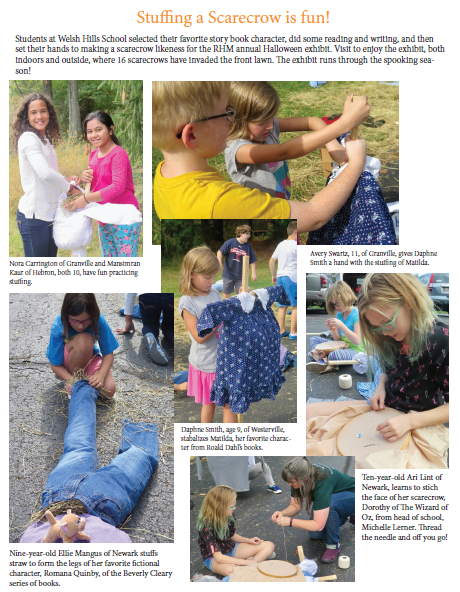Editor’s Note: the full articles noted in this story are archived on this website and can be read in their entirety. Thanks to the author and friend of Robbins Hunter Museum, William Heyer, for his research and interpretations of earlier days when grand homes like the Avery-Downer house were conceived and constructed.
The Avery-Downer House, home to the Robbins Hunter Museum, celebrated its 175th year this year and thanks to nationally recognized classical architect, William Heyer, we learned much about the history of the building, its creators, and the culture that permeated the times.
Heyer, who is from Columbus, has long been actively involved at the Robbins Hunter Museum. As a member of the Board in the early 2000's, he created measured drawings of the interior and exterior of the building and researched appropriate finishes. More recently, he designed the Knobel Folly, an appropriate addition to the Jill Griesse garden. On May 5, he led a walking tour of downtown Granville with emphasis on the Avery-Downer House and St. Luke's Church.
Over this year, Heyer wrote a three-part series of extensive and in depth articles for this newsletter, articles that are now archived here.
In the first article, published in April 2017, Heyer wrote about the fasciation of temple design and the unusual habit of building temples in the 1840’s as homes.
“The notion that a young family would live in a Greek temple in America is quite reasonable and beautiful, actually. These young Americans in the first half of the 19th century prided themselves on their new democratic republic—a form of self-government that had its origins in ancient Greece. These young Americans also believed in individual rights quite apart from any monarchy, aristocracy, or other system of oppressive government. Hence, man was a special creature, endowed by the Creator with rights and value above and beyond royalty.”
Then he talked about Albert Avery.
“Alfred Avery began his entrepreneurial career in Granville as a drover taking livestock to eastern markets like his future business partner and brother-in-law Lucius Mower. On their travels, they would have seen some of the stately Greek Revival mansions being built and possibly had come in contact with other businessmen who were commissioning their own temple houses. Further, they quite possibly would have been introduced to the architectural pattern books of Asher Benjamin, John Haviland and others that were widely disseminated in the early 19th century. From all accounts, the tradition of grand domestic architecture was something any young aspiring entrepreneur like Avery would have been interested in at this time….Avery came to acquire the double lot at 221 E. Broadway about 1837, about the same time he helped organize and complete a building campaign for his own church, St. Luke’s Episcopal.”
The second article, published July 6, explored the fascinating symbolic meanings behind entrances, in particular the front entrance.
“Since ancient times, the entrance to houses, temples, mausoleums, and civic buildings has symbolized an engagement with the world, the cosmos, the other side of death, the body politic. ‘Crossing over’ has intense meaning for us. It is a transformation in one way or another, a progression into the future, a conversion, a symbol of freedom or welcome, and a way forward to things previously unknown and unseen.”
Heyer acknowledges the classical inspiration behind the frontispiece of the Avery-Downer house, and recognizes its uniqueness.
“In 1842 when Alfred Avery was planning and designing his home on East Broadway, he certainly had in mind a timeless and yet personal sense of entry. The frontispiece surrounding the main north door is a masterpiece of Grecian design. It might seem redundant, interestingly, that a temple house should have an especially decorated doorway when it has the power of the Ionic temple speaking so clearly to the public. In reality, the two are quite opposite each other because the Ionic temple projects in an active way to engage the public while the frontispiece seems to fold inwards in a passive and receptive way. They both balance each other with their distinct purposes. One is strong and active, the other gentle and receptive. This is a brilliant showcase of the refined classical tradition in American architecture.”
And in the third and final article, published November 3, Heyer turns to the men who inspired each other and who shared a love for the architecture: Granville’s great entrepreneur and philanthropist Alfred Avery, celebrated architect Minard Lafever, and gifted builder Benjamin Morgan, builder of St Luke’s and Avery’s own house at 221 E. Broadway.
“We know that Avery, Lafever, and Morgan were instrumental leaders in the building of St Luke’s and we know that Alfred Avery was a major player in the financing and building of the Ohio canal system.
…Alfred Kelley was the celebrated first Mayor of Cleveland, a State Representative, and the genius behind Ohio’s canal system. He had been “pushing for canal bills through the state legislature, had personally surveyed land, signed contracts, and kept diligent records.” He was one of the most important figures in 19th century Ohio. Alfred Avery of Granville, also a canal financier, was almost certainly present that day having held a large sum of money in contracts to build the canal and would have wanted to see the beginning of his investment with all the fanfare and celebrated personalities present.
…The beauty of the new temple house of his acquaintance Alfred Kelley and the beauty of the new church of St. Luke’s most certainly influenced his decision to rely on Minard Lafever and Benjamin Morgan for the design of his own Ionic temple at 221 E. Broadway.”
And so, this year we have celebrated the history of our house, the Avery-Downer House.



























